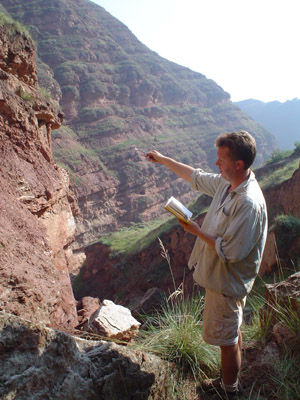Global Continental Cooling
Guillame Dupont-Nivet and colleagues recently presented new evidence for significant global cooling at the Eocene-Oligocene boundary, about 33.5 million years ago, when the Earth cooled from ?greenhouse? to ?icehouse? and permanent ice sheets arrived in Antarctica (Nature 8 February).
 Why did you decide to pursue this approach?
Why did you decide to pursue this approach?
The interactions between mountain building and climate change are the center of interest in Earth Sciences today.
The Eocene-Oligocene transition from an "icehouse" to a "greenhouse", when the ice caps started to grow over Antarctica 34 million years ago, is one of the most dramatic global climate event ever recorded. At his time the collision between the Asian and Indian tectonic plates were in the process of forming the Tibetan plateau, the highest elevated region in the world. The past climate of this region is however poorly understood and dated such that the respective influence or possible interconnections between uplift of the Tibetan Plateau and the Eocene Oligocene transition are still unknown. For these reasons we decided to study and accurately date the sediments that have recorded climate changes in this region.
Photo: Earth scientist at work in the Tibetan plateau region (Wout Krijgsman, Utrecht University) analyzing sedimentary cycles deposited during the Eocene-Oligocene transition from an "icehouse" to a "greenhouse" world climate.
Photo by Guillaume Dupont-Nivet
What's significant about your findings?
We found that the disappearance of lakes indicating aridification on the Tibetan plateau occurred precisely at the same time when the Antarctic ice cap started to form at the Eocene Oligocene climate transition 34 million years ago. This indicates that this climate change was not restricted to the poles but had a profound effect elsewhere in the world, within the heart of the continental interiors.
What are the implications of your work? how does it help with climate modeling today?
Computer models of climate evolution need ground proofing from studies of past climate to constrain their boundary conditions. Ocean records provide the largest available datasets for past climate but the existing continental record is discontinuous in time and provides only a scattered geographic coverage. Rare continental records such as provided in our results are important to understand the different impact that climate change will have on continents and in oceans.
How will you be taking your research forward?
In this particular research topic, we are planning to look at different climate proxies in our records to try to quantify the changes in temperature, precipitation and vegetation associated with the climate change. We want to test whether declining levels of atmospheric CO2 are the driver of the climate change rather the generally accepted hypothesis that climate cooling resulted from the opening of a sea passage around Antarctica at this time. We would also like to test the proposed hypothesis that the driver for declining CO2 levels is the erosion related to the uplift of the Tibetan plateau.
For more details and other research topics you are invited to check out my website at http://www.geo.uu.nl/~forth/people/Guillaume
G. Dupont-Nivet et al., Nature, 445, pp 635-638






